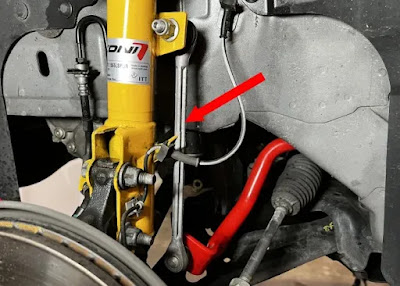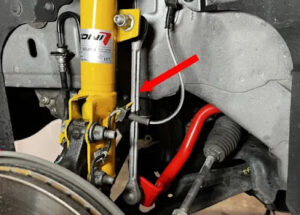Sway bar links are an essential component of a vehicle’s suspension system. They play a crucial role in improving handling and stability, especially during turns and maneuvers. Proper maintenance and tightening of sway bar links are essential to ensure optimal performance and safety on the road.
What are Sway Bar Links and How Do They Work?
Sway bar links, also known as stabilizer bar links, are connecting rods that link the sway bar (also known as the stabilizer bar) to the suspension components of a vehicle. The sway bar is a metal bar that runs horizontally across the front or rear of the vehicle and is connected to the suspension on both sides. The sway bar links connect the ends of the sway bar to the suspension components, allowing it to transfer forces between the wheels on each side of the vehicle.
The main function of sway bar links is to reduce body roll during turns and maneuvers. When a vehicle turns, the weight shifts to one side, causing the body to roll or lean. The sway bar links help to counteract this roll by transferring forces between the wheels on each side of the vehicle. This improves stability and handling, making the vehicle more responsive and easier to control.
The Importance of Properly Tightening Sway Bar Links
Properly tightening sway bar links is crucial for optimal performance and safety. If the sway bar links are not tightened correctly, it can lead to various issues that can affect the handling and stability of the vehicle.
Over tightening sway bar links can put excessive stress on the suspension components, leading to premature wear and potential failure. On the other hand, under tightening sway bar links can result in loose connections, causing rattling noises and reduced effectiveness of the sway bar.
Signs of Over Tightening Sway Bar Links
Over tightening sway bar links can have negative effects on the vehicle’s handling and stability. It is important to be able to identify the signs of over tightened sway bar links to address the issue promptly.
One of the most common symptoms of over tightened sway bar links is a stiff or harsh ride. The vehicle may feel rigid and less responsive to steering inputs. Additionally, over tightened sway bar links can cause excessive noise, such as squeaking or clunking sounds, especially when going over bumps or uneven surfaces.
How Over Tightening Sway Bar Links Affects Handling and Stability
Over tightening sway bar links can have a detrimental effect on the vehicle’s handling and stability. It can lead to a harsh and uncomfortable ride, as the suspension is unable to absorb bumps and vibrations effectively. This can result in a loss of control and reduced maneuverability, especially during turns and sudden maneuvers.
Furthermore, over tightened sway bar links can cause uneven weight distribution between the wheels, leading to imbalanced handling. This can result in understeer or oversteer, where the vehicle either tends to push forward or fishtail during turns. These handling issues can be dangerous and increase the risk of accidents.
The Impact of Over Tightening Sway Bar Links on Suspension Components
Over tightening sway bar links can put excessive stress on other suspension components, leading to premature wear and potential failure. The increased tension can cause the bushings, ball joints, and other connecting points to wear out faster than normal.
If left unaddressed, the damage caused by over tightened sway bar links can extend beyond the sway bar links themselves. It can lead to costly repairs, such as replacing worn-out bushings or ball joints. Neglecting sway bar link maintenance can result in more extensive damage to the suspension system, requiring expensive repairs or even replacement of major components.
The Dangers of Over Tightening Sway Bar Links for Off-Road Driving
Over tightening sway bar links can have even more severe consequences for off-road driving. Off-road conditions are already challenging for a vehicle’s suspension system, and over tightened sway bar links can exacerbate these challenges.
Off-road driving often involves traversing uneven terrain, such as rocks, mud, and steep inclines. Over tightened sway bar links can limit the suspension’s ability to articulate and absorb the impact of these obstacles. This can lead to a rough and uncomfortable ride, as well as potential damage to the suspension components.
Moreover, over tightened sway bar links can increase the risk of vehicle rollover during off-road maneuvers. The limited suspension travel can cause the vehicle to become unstable, especially when navigating steep inclines or off-camber situations. This can result in a loss of control and potentially dangerous situations.
How Over Tightening Sway Bar Links Can Cause Uneven Tire Wear
Over tightened sway bar links can also cause uneven tire wear. When the suspension is not able to move freely and absorb bumps and vibrations, it can lead to excessive tire wear on certain areas of the tire tread.
Uneven tire wear can result in reduced traction and handling performance. It can also lead to premature tire failure and the need for frequent tire replacements. Regular tire rotation and alignment are essential to mitigate the effects of over tightened sway bar links and ensure even tire wear.
The Role of Regular Maintenance in Preventing Over Tightening Sway Bar Links
Regular maintenance and inspection of sway bar links are crucial to prevent over tightening and other issues. It is recommended to check the sway bar links during routine maintenance intervals or whenever there are signs of handling or stability issues.
During maintenance, it is important to ensure that the sway bar links are properly tightened according to the manufacturer’s specifications. This can help prevent excessive stress on the suspension components and ensure optimal performance.
How to Properly Tighten Sway Bar Links to Avoid Negative Effects
Properly tightening sway bar links requires following a step-by-step process and using the right tools. Here is a guide to properly tighten sway bar links:
1. Lift the vehicle and secure it on jack stands.
2. Locate the sway bar links and inspect them for any signs of damage or wear.
3. Use a wrench or socket to loosen the nuts or bolts securing the sway bar links to the suspension components.
4. Remove the old sway bar links if necessary and replace them with new ones.
5. Tighten the nuts or bolts according to the manufacturer’s specifications. It is important not to over tighten or under tighten them.
6. Lower the vehicle and test the handling and stability to ensure proper installation.
Seeking Professional Help for Sway Bar Link Issues
If you are unsure about how to properly tighten sway bar links or if you suspect any issues with your vehicle’s suspension system, it is recommended to seek professional help. A qualified mechanic or technician can inspect and diagnose any problems with the sway bar links and provide the necessary repairs or adjustments.
Choosing a reputable and experienced professional is important to ensure that the job is done correctly and safely. They will have the knowledge, expertise, and specialized tools to properly tighten sway bar links and address any other suspension issues.
Conclusion
Proper maintenance and tightening of sway bar links are essential for optimal performance, handling, and safety. Over tightening or under tightening sway bar links can have negative effects on the vehicle’s handling, stability, and other suspension components. Regular maintenance and inspection, as well as following proper tightening procedures, can help prevent these issues and ensure a smooth and safe driving experience. Vehicle owners should prioritize the care and maintenance of their sway bar links to avoid costly repairs and potential safety hazards.

